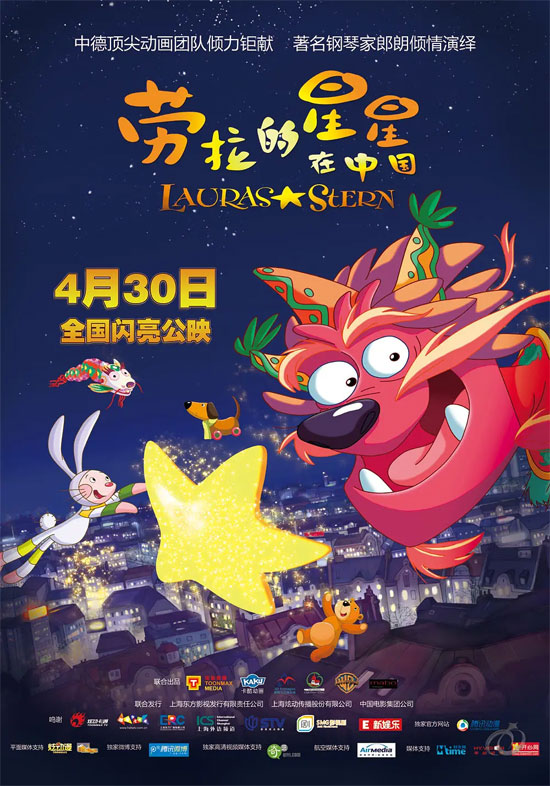Film Name: 劳拉的星星在中国 / Lauras Stern und der geheimnisvolle Drache Nian

Despite the involvement of Chinese screenwriters, “Lauras Stern und der geheimnisvolle Drache Nian” retains a distinctly Western fairy tale core—a remarkably precise grasp of children’s psychology and a gentle, unhurried narrative style.
At times, I feel Laura and her star’s story is essentially a German version of “My Neighbor Totoro.” Both feature a mysterious companion from a semi-unknown world, both possess magical powers, both are visible only to children—parents and other adults are utterly blind to them—and both form bonds of trust and mutual aid with the protagonist…
While Totoro emerges from the rural forest, the star originates from the sky. Both the forest and the sky are natural phenomena children comprehend, lending credibility and intimacy to the mystical companions born from these realms. Magical powers form a core attribute for both Totoro and the star, as children aged three to seven begin developing imagination—they firmly believe in Santa Claus precisely because magical abilities captivate them most. The Totoro never appears before adults, and Laura keeps her star safely tucked away in her bag. The premise that only children can experience these mysterious beings reflects the author’s admiration for childhood innocence while also catering to a common childhood desire—the urge to keep wonderful things all to oneself. Moreover, trust forms the bedrock of the narrative value in both “My Neighbor Totoro” and “Laura’s Star.” The bonds of trust children forge with these mysterious beings resonate deeply with this age group’s psychological need for friendship—they are no longer solely fixated on parental love but begin to seek the security offered by trusted companions.
Like “My Neighbor Totoro,” “Laura’s Star” contains little humor. This isn’t a failure of the screenplay but a fundamental characteristic of children’s literature. Young children aren’t particularly drawn to humor; adorable creatures or comedic actions provide far greater visual stimulation than witty dialogue offers intellectual stimulation. This marks an essential difference from youth-oriented and adult animation. Children find amusement in the protagonist rolling around on the sleeping Totoro, develop longing through the star’s affection for Laura, and even chuckle at simple actions like the yak fetching Lingling’s shoe. Yet they remain utterly unmoved by the various witty banter between adults. This is precisely why “Lauras Stern” minimizes the kind of banter commonplace in American blockbusters. Moreover, both Totoro and the star are endearing creatures. Though neither speaks, each possesses a unique charm that captures children’s hearts: Totoro with his round, plump, and fluffy appearance, and the star with its smooth curves and luminous glow.
The film “Lauras Stern und der geheimnisvolle Drache Nian” strives to heighten dramatic tension by introducing the ominous clouds threatening the star early on, creating a sense of impending danger. This deliberate emphasis on peril actually clashes with the original “Lauras Stern” story’s gentle, pure narrative style. Compared to the story of “Tonari no Totoro,” this heightened tension feels somewhat commercialized and formulaic. Personally, I consider this a minor misstep. “Tonari no Totoro” ultimately avoids introducing a so-called final boss; instead, the children’s mother falls ill, and Totoro uses his magic to take them to visit her. This maintains a consistent sense of quiet authenticity throughout. “Lauras Stern” should have maintained this narrative approach: from Laura’s home to Lingling’s grasslands, their reunion, the unfolding events, and finally resolving a minor challenge through trust in the stars—without necessitating the defeat of the dark clouds. The film deliberately introduces the dark clouds as the ultimate adversary, yet the depiction of the final showdown feels rushed and lacks credibility, ultimately undermining the story.
Another notable strength of this film is its outstanding background music. While it lacks the Disney-style musical interludes, the consistently melodious and pleasant main theme effectively enhances the film’s warm and cozy atmosphere throughout.
Please specify:Anime Phone Cases » Lauras Stern und der geheimnisvolle Drache Nian 2009 Animation Film Review: The German Version of the “My Neighbor Totoro” Story